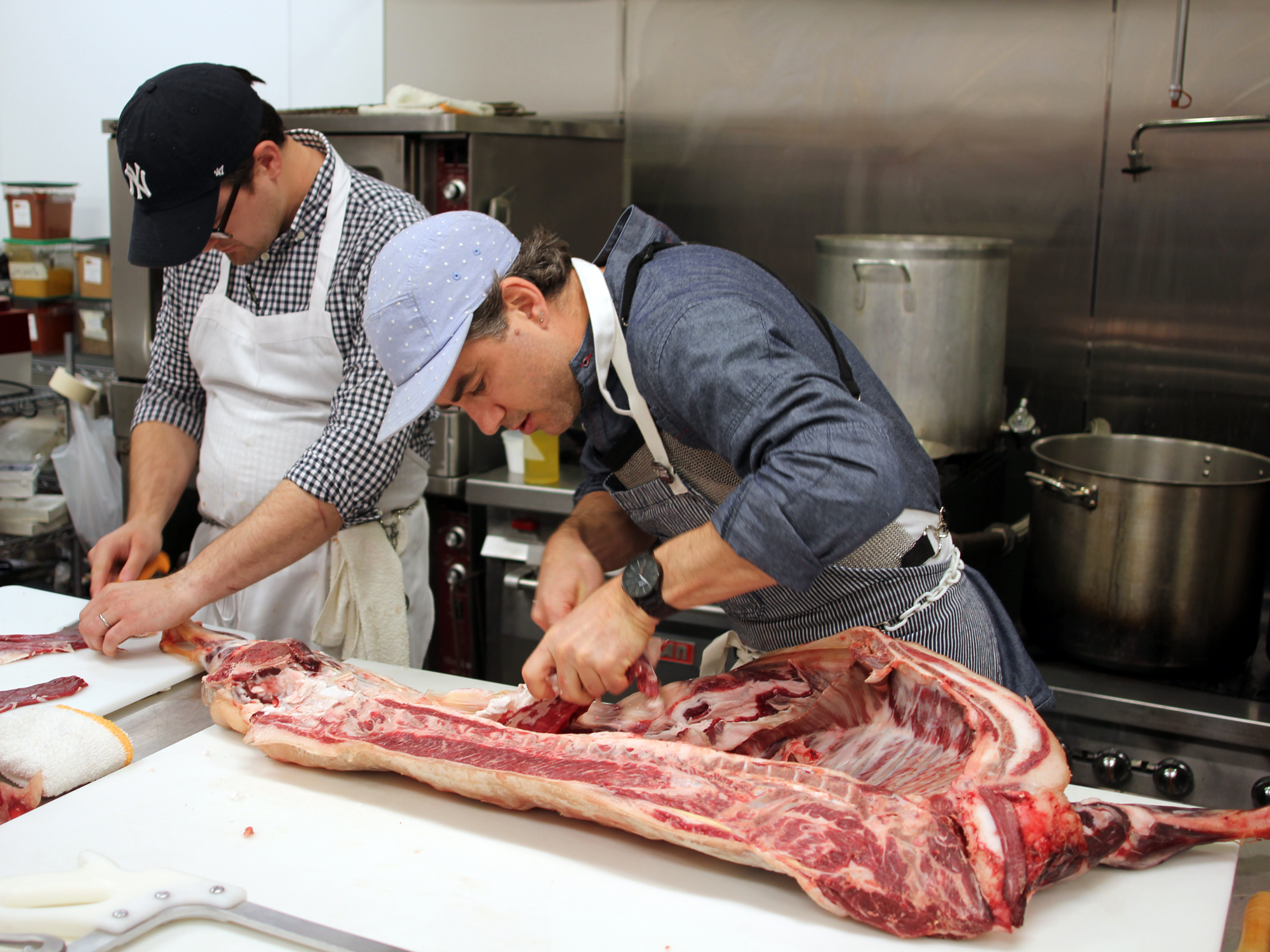GREG WADE JUST SAID SOMETHING ABOUT being able to tell good handmade bread from industrial bread by its exterior, so I stop him and ask him to grab a loaf and go all Sherlock Holmes on it. He obligingly grabs a crusty, walnut-brown loaf, and starts telling me what to look for.
“When you shape a loaf of bread and you ferment it cold overnight, the carbon dioxide that’s let off through the fermentation process has the ability to get right underneath the skin of the bread,” he says. He points to some tiny blisters on the crust. “When we hit that with heavy steam, that just kind of bubbles and bursts. When you see that sort of thing you can really tell that the bread was fermented cold for a long time.”
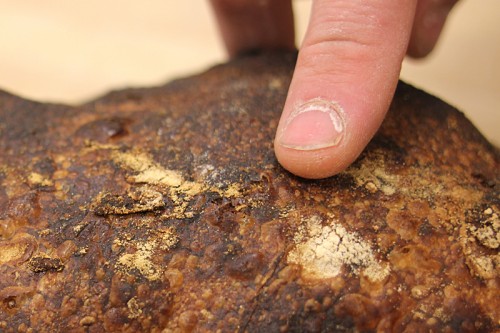
“Okay,” I say, “I have to ask you something I’ve been wondering about for years. How does steam, which makes everything else soft, make bread hard?”
“Ah, well, the thing is, it doesn’t actually make the bread hard,” he says. “What steam does, when you flood the [oven] chamber with steam, is make a moist baking environment, which prevents the crust from forming too soon. My bread’s able to rise fully, so it’s able to get a larger volume. Once I see that it’s fully risen and has the right crust color, I pull the steam out of the chamber, and then it’s able to crisp up. It’s not a wet baking environment the whole time.”
“So what else can we deduce from the look of a loaf of bread?” I ask.
“Let’s see by slicing it open,” he says.
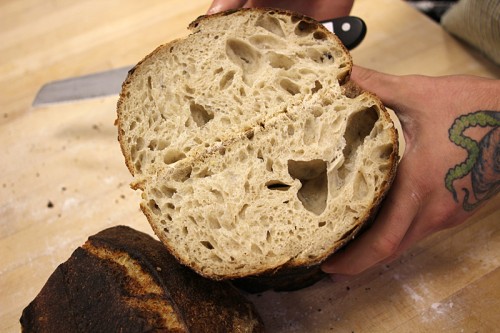
He scrounges up a knife and slices off a hunk of the loaf we’re looking at, then makes another cut and folds it back as if hinged in the middle. “You can really see the large, irregular holes here. That’s a good thing,” he says. “That speaks to, one, the sourdough levain, but also, all of our doughs go through what’s called an autolyse process. That’s a resting period that the dough goes through, without yeast and without salt, that develops these long gluten chains. In order for those chains to develop, we want the dough to sit there for as long as possible as just one giant mass, without yeast which would be pushing those chains apart. And without the salt, which strengthens the ionic bonds between those chains.”
“Wait, you don’t want the ionic bonds between the gluten chains strengthened?” I ask, my knowledge of chemistry failing rapidly.
“We want them to develop as long as they can, and then we add the salt to lock them up,” he says.
“Ohhhhkaaaay,” I say, wondering how anybody ever figures stuff like that out in the first place, especially when the first place was probably France in the 1600s, when they believed bread rose because angels belched into it or something. “Maybe—could you show me the whole process?” I ask.
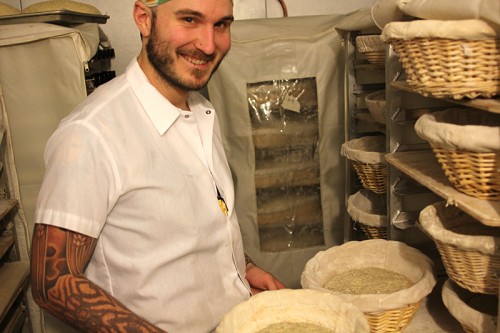
Greg Wade in the walk-in.
TALL, YOUNG AND QUIETLY DRIVEN, Greg Wade got into baking like a lot of cooks go into food—by starting out in college and deciding he liked food more than what he was studying. “When I was real young, I’d bake with my grandmother, cookies and things, and that was a good memory for me,” he says. “I was originally going to the University of Wisconsin in Milwaukee to be a German teacher. And that just didn’t pan out, I wasn’t really into it. And I got a call from a culinary school down here, that said hey, come to culinary school—”
“How’d they find you?” I ask.
“Turns out, when I was first applying to schools about two years earlier, my mom had signed me up on their website, she knew that I liked cooking,” he explains. “It was perfect timing, and I said, let’s do it. It was the Illinois Institute of Art. And I really took advantage of the skill labs. You could go to a chef and say, hey, I want to work on X, Y or Z, and they’d order you the product and you could just practice.”
He went to work at Taxim, doing savory and pastry but also baking bread when he could. He met Jan Rickerl there, and followed along when he left Taxim to be chef de cuisine at a long-in-the-works restaurant called Girl & the Goat, which had an in-house bakery and eventually would open a separate bakery facility of its own. He baked at Girl & the Goat and then Little Goat before joining PQM—as it prepared to do the same thing and launch a separate bakery as well.
Gallery: The Breads of Publican Quality Bread
THE PROCESS STARTS WITH A PLASTIC TUB, FLOUR, water—but no added yeast. This is what he calls a soaker, and all it is is some flour mixed with a little water and left to sit and develop—with the help of a few wild yeasts still on the grain when it’s milled. Which points to another thing that’s different from industrial bakeries—much of the flour comes from local farms, notably Spence Farm, about halfway between Kankakee and Bloomington, which helps account for its look, which in the case of a whole grain bread is more like porridge (or a chocolate shake) than dough.
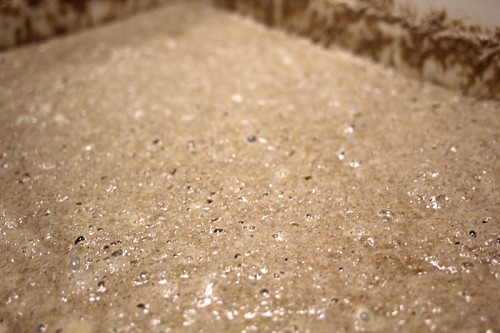
“This is something that really makes our program special,” Wade explains. “We take whole grains that we get from local farms, and mix them with water and let them sit at room temperature for 24 to 36 hours. You can already see all these bubbles and all this activity, that’s a good thing, and they just start fermenting because of all the wild yeast on the grain at harvest. That makes it super tasty, super flavorful. You can kind of even smell it—it’s one of my favorite smells in the world.”
That’s one of the ingredients that goes into the bread at an early stage. Another is the levain, or sourdough starter, which at first glance might seem the same thing as the soaker—the difference is that it’s much richer with active yeast. “We feed it three times a day, flour and water, and you just have to wait for it to ferment and be lively and active. We usually put about ten to twenty percent levain in the dough, it depends on how much whole wheat there is in the dough, and also what type of grain it is. With wheat flour it’s generally a little bit less, because it still has a lot of gluten structure being developed. With something like oat flour, which doesn’t have any gluten, it’s going to be a little bit harder to rise and you need a little more levain to still have a nice, fluffy product.”
“You take that guesswork out of it, but you also take the skill and the love out of it, too.”
I ask him specifically what each of these elements, the soaker and the levain, contribute. “The soaker really gets a little more enzyme activity going, so it’s going to give life to your bread,” he explains. “So despite us fermenting our bread for 60 hours, by going through processes like this our dough is still going to be alive after those 60 hours, it’s still going to have oven spring, it’s still going to have crust color, that sort of thing. And for whole grains, this helps soften the grains.”
He drags a tub of the levain over and opens it. “What the sourdough starter contributes is, of course flavor, but also those big holes. You’re also getting flavor improvement, texture improvement, through the organic acids that are developed through this process,” he explains. “Sourdough is also a natural preservative, and all of our flours have no additives, no enrichment, no dough conditioners, it’s all the processes that we put the dough through that give us a long shelf life and workability.”
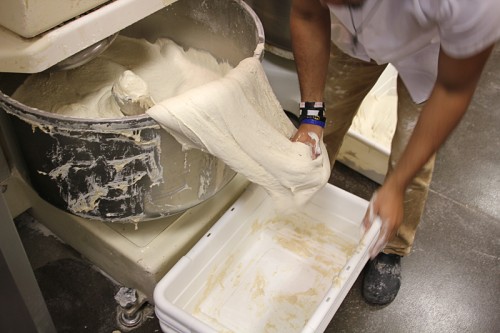
“What’s a dough conditioner?” I ask.
“A dough conditioner makes the dough very quickly and easily worked. When we take our doughs out of the mixer, they’re very sticky and tacky and dense. We have to wait for them to rise, and knock it down, and rise again,” he explains. “It’s kind of like using a commercial emulsifier to make aioli. You take that guesswork out of it, but you also take the skill and the love out of it, too.”
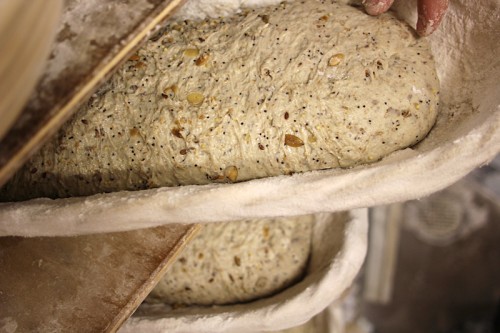
NEXT WE’RE IN THE WALK-IN cooler, surrounded by doughs at various stages, shaped into boules and loaves. “What goes in here is all of our dough to be baked today,” he explains. “Two days ago, we made the soaker. We made all of this dough and shaped it yesterday, and then refrigerated it overnight—sourdoughs go overnight; commercially leavened doughs get baked the same day. And then we’ll pull it out this evening and bake it tonight, to be delivered tomorrow.” This stage, called a retard, helps the bread develop flavor, but it also slows everything down so that the baker can take loaves out and let them warm for baking as needed—there’s no pressure to get it all baked within a certain window.
“Since we’re doing everything in the same order and generally at the same time every day, all of our doughs are fermenting for the same time every day.” He lays out the schedule for me—”The drivers get in at 4 or 5 am, the mixer gets in at 8, the shapers get in at 10, and the baker will get in at 2 in the afternoon.”
That’s very different from how Publican Quality Bread operated when Publican Quality Meats started in 2012. Back then the idea was that the restaurant would close in the afternoon and the bread crew would work through the evening and into the night. It seemed an efficient use of near-downtown real estate, but I saw the problem with it when I shot pictures of a Three Floyds dinner at PQM—whenever they had to share the space, the cooking crew was stumbling over the poor bakers at every turn.
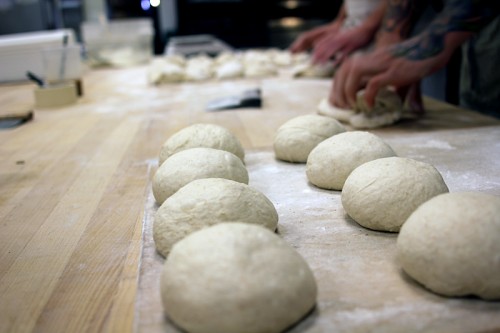
In the end, it proved to be too difficult to get people to commit their lives to baking bread through the middle of the night, and they built a second facility a block away on Lake, dedicated to baking and with hours that were a little closer to the rest of humanity. (You can see it, it’s not exactly secret, but to buy anything you still have to go to the shop in PQM or other places that carry their bread, including Local Foods and Treasure Island. It’s also in about 30 restaurants, which besides the One Off Hospitality restaurants include Shaw’s Crab House, Soho House, Lula Cafe and others.)
Wade and a baker named Nick Averill (who he’s worked with since Girl & the Goat) roll out boules, rolling them two at a time, one under each hand, like turning big round knobs in opposite directions. “I worked there for like six months before we were able to open this place, on recipe development and testing and things like that, and it was 5 pm that I was able to get there and we’d go till 3 or 4 in the morning. It wasn’t terrible, but it was rough,” Wade says. “When you’re asleep through the whole lifetime of the day, and there’s nothing open when you get off your shift—it was just rough. Even at Girl & The Goat, when I was baking there, I would get in at 4 or 5 in the morning—I was like 20 at the time—I’d be up at 3 something, all my friends are going out, and ‘this sucks.'”
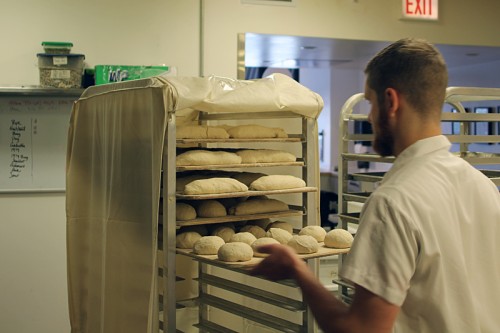
“But I think that people who really want to bake bread—we don’t mind,” he says. “When you do fall in love with making bread, you don’t really care. You just want to do it. If that’s the time that you get to do it—that’s when you do it.”
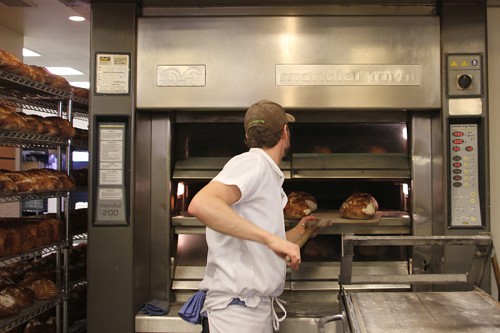
I’VE KNOWN A FEW PEOPLE WHO’VE MASTERED bread like this, but the fact is that I’ve known fewer who kept at it once they had. Where you can hear the excitement of new things with Greg Wade is when you talk about the grain they use—especially from the Spence Farm Foundation, near Fairbury, Illinois.
“What we think we do really well is our naturally fermented breads with whole grains,” Wade says. “Our sourdough features wheat and rye from Spence Farms, and it’s fermented for 60 hours. Our 1979 multigrain, naturally leavened, I think is indicative of our program, we want to produce a good, natural, healthy product, but also have it be super-tasty.”
“We do a rye berry, we take cracked rye and make a soaker out of that. We make a very wet dough, that also ferments overnight. Something that I like about that one is, most rye breads have something like caraway or onion in them. The result is that people don’t really know what rye tastes like. That one lets the actual grain shine through. And other than that, I’m working on a corn meal and roasted potato bread with a little bit of black pepper. That’s going to be our seasonal bread for fall. And we’re doing a seasonal fruit and nut bread. We’re taking oat flour from Severson Farms, and making our soaker out of it with a little bit of flour from Spence Farms, and then we’re taking a little bit of honey, we’ll naturally leaven it, and then a little bit of peanuts and diced apples.”
When you do fall in love with making bread, you don’t really care. If that’s the time that you get to do it—that’s when you do it.
It all sounds good, but why does it matter if you use a particular flour from a particular farm? “Well, like most things in my life I owe it to Stephanie Izard,” the chef of Girl & the Goat, he explains. “She was ordering from Marty [Travis of Spence], and he and I got to talking one morning. He was growing just winter wheat at the time, and he said you’re a baker, you should try it.”
“I did and it was great,” he says. “So we kept on talking. That’s how he operates, he kind of just talks to his customers and says, well, what do you want. We were talking about different kinds of grains, and what time of the year he could grow them in. So he started doing winter wheat, and then he started doing spring wheats, and then oats and barley, he’s doing rye now for us, and I actually donated a bunch of money to him to be able to get einkorn seed,” an ancient grain that originated in Turkey.
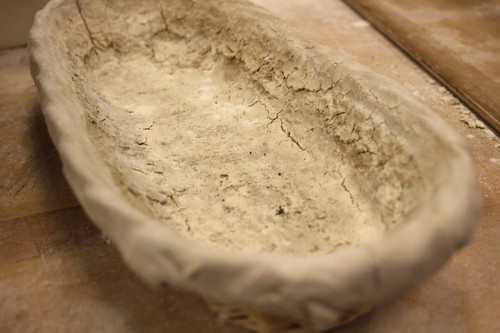
“It’s become way more of a relationship than just being a farmer or a vendor and a baker,” he says. “We do things like take bakers down to the farm and show them everything that goes into production, and then I teach them how to make bread down there.”
“It’s really become more of a community, and much more tied-together than I ever thought a producer and a baker could be,” Wade says. “His successes are my successes, and mine are his. We’re trying to move this forward together—which is a lot more beneficial than if I’m just baking bread, and he’s just growing grain.”
Michael Gebert is the best thing since sliced bread as editor of Fooditor.
Latest
Join the Discussion
After you comment, click Post. If you're not already logged in you will be asked to log in or register with Disqus.












